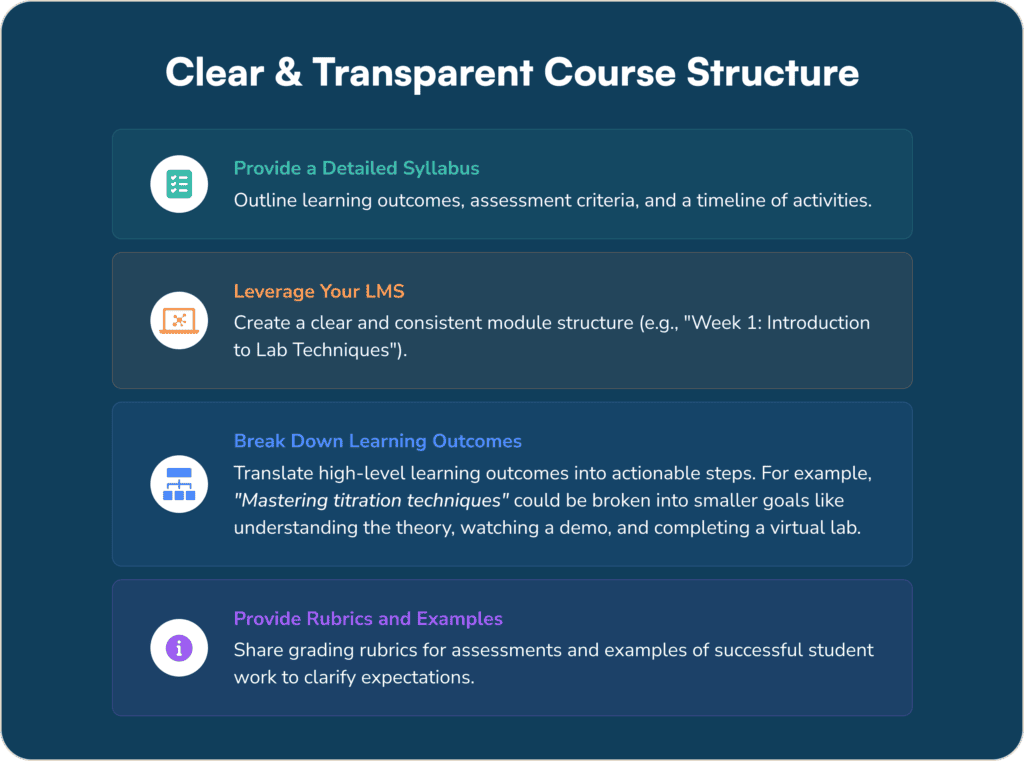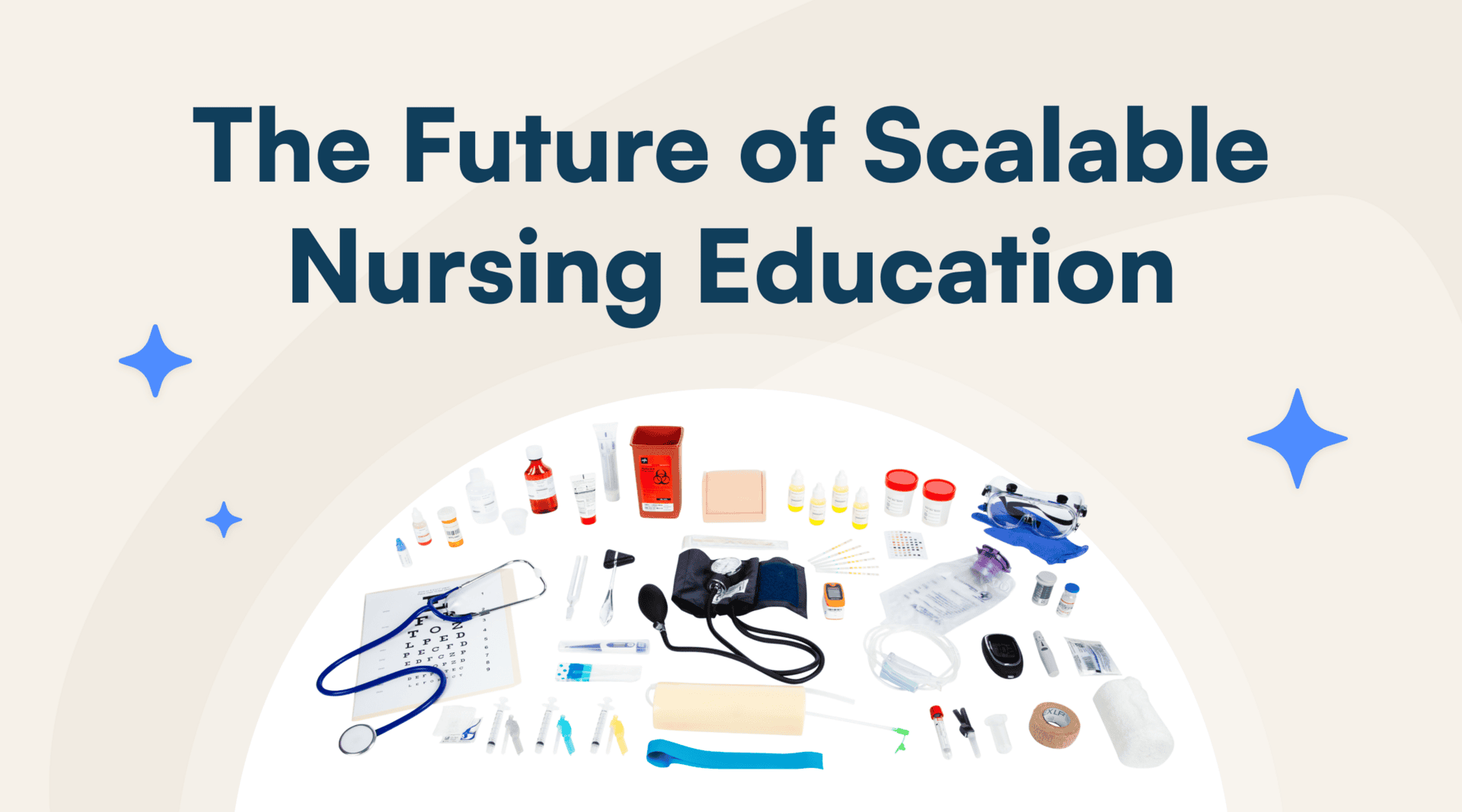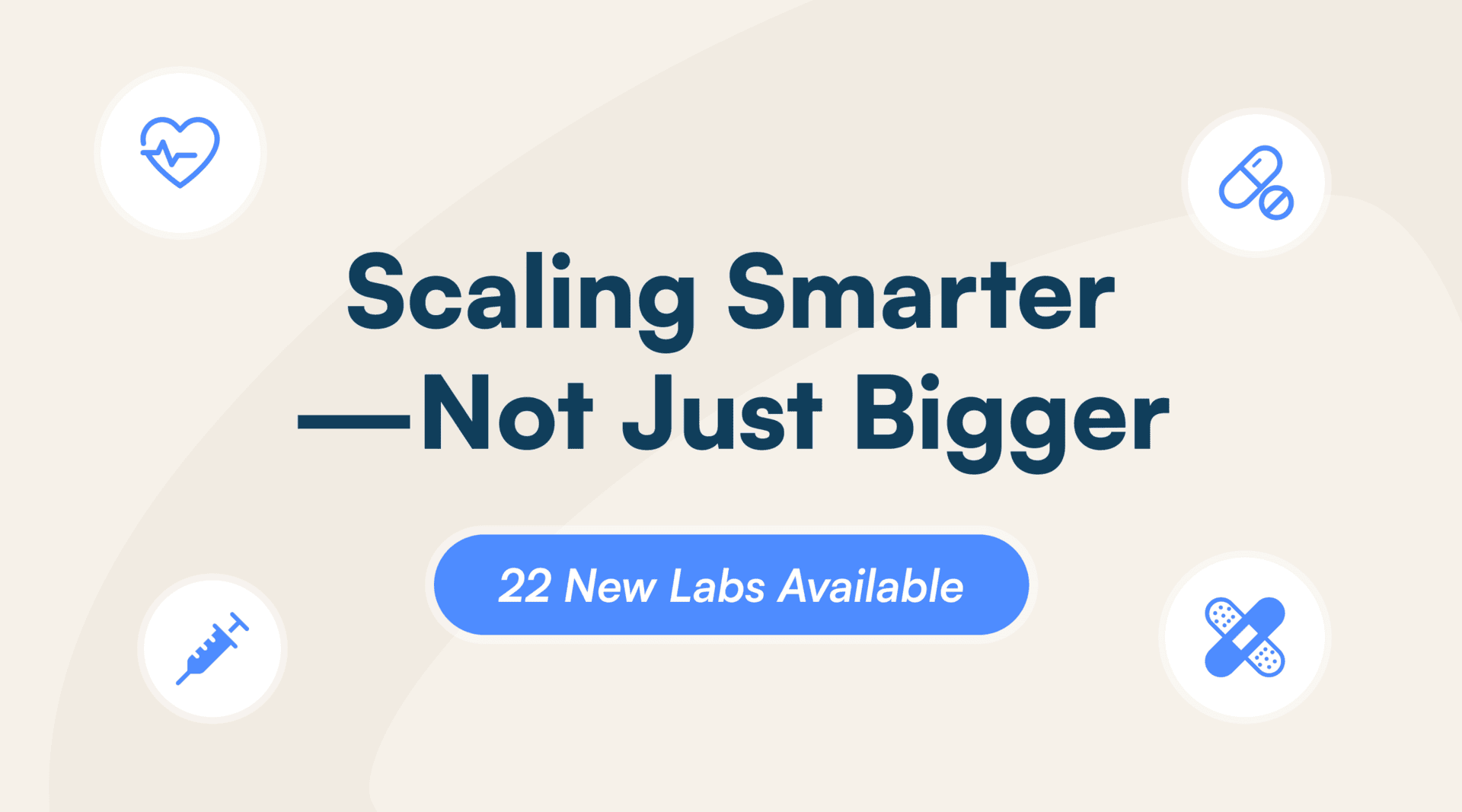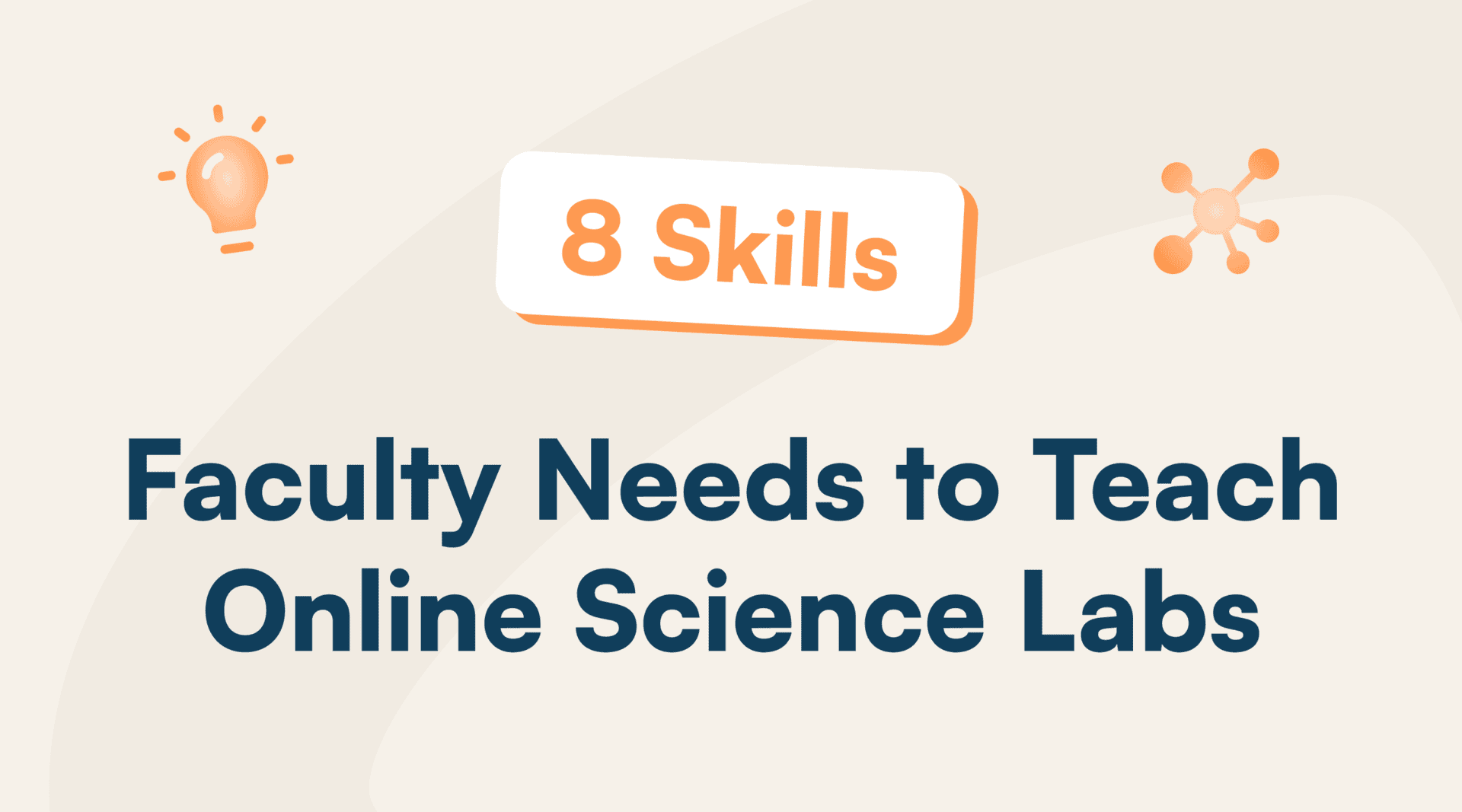Summary
One of the most important aspects of introducing new online courses or transitioning your on-campus labs to an online setting is ensuring your faculty know how to teach science labs online. It can make or break the success of your online courses, which is why devoting time and resources to supporting online instructors is integral.
You play a pivotal role in ensuring your faculty are not only equipped with the right tools and skills but also empowered to adapt and thrive in an online teaching environment. Consider this guide your starting point for that journey, providing a framework to build resilient and effective online science labs that meet the needs of both faculty and students.
Whether you’re overseeing a single course or an entire department/program, you can set up instructors for success and drive positive learning outcomes for students because when faculty feel supported, their students will feel it.
So what skills do instructors need to effectively teach online and how can you support and prepare them?
Skill 1: Understand the Core Challenges of Teaching Online Science Labs
Before teaching online, instructors have to understand the unique challenges of this modality, which differ significantly from traditional, in-person courses, especially those with lab components. Faculty must address issues such as technology set up and troubleshooting, the difficulty of replicating on-campus hands-on experiences virtually, and ensuring student engagement in a remote or asynchronous setting.
In fact, according to the 2024 Annual Lab Report, nearly 80% of administrators said recreating a hands-on experience are key challenges in online labs. Still, about 90% of deans/department chairs and instructors said they were satisfied with their online labs, and the knowledge and skills students gained, because they were able to effectively incorporate hands-on labs and virtual simulations to engage students.
The lesson? The better equipped instructors are, the better their abilities to drive student success. That said, instructors new to or not very experienced in teaching courses and labs online will come up against some common obstacles:
- Lack of familiarity with online tools and technologies means instructors can’t create an engaging, collaborative, and cohesive learning experience online.
- Difficulty replicating hands-on experiments limits how much and how well a student can understand course material.
- Assessment and evaluation: Measuring hands-on skills in an online environment can be challenging. For instance, evaluating the precision of pipetting techniques virtually is far less accurate than in person.
- Student engagement: Keeping students motivated and focused without the physical presence of an instructor requires innovative engagement strategies.
The good news is that you can help. With the proper training and allocation of resources, you can ensure faculty are prepared and confident in their abilities to deliver effective online lab courses.
Skill 2: Ensure Clear & Transparent Course Structure
Curriculum should be intentionally designed for the online environment. This isn’t just about uploading content to your LMS and creating a passive learning environment. It’s about adapting and transforming it to meet the needs of today’s digital learners.
Consider how content is delivered…its accessibility, interactivity, flexibility, and the provision of adequate support and feedback—all while ensuring clear alignment with learning objectives and effective time management. Curriculum tailored to an online environment leverages the unique strengths of digital learning and addresses the specific challenges and opportunities of online learning settings.
In addition to using high-quality curriculum aligned to Quality Matters standards, be sure your course has a clear and transparent structure for students.

Skill 3: Tailor Teaching Strategies to Prioritize Hands-on Learning
Hands-on learning is central to STEM lab courses, and replicating this experience online requires creativity and strategic planning, along with other reinforcements for a truly enriching online learning experience.
Key approaches for instructors:
- Hands-on labs with kits: Partner with vendors to send affordable, pre-assembled lab kits to students, containing all of the materials and equipment they would need to conduct hands-on lessons at home.
- Virtual simulations: Reinforce that hands-on learning with virtual simulations, giving students a low-stakes opportunity to re-run experiments, augment learning, and deepen engagement with the course material.
- Real-time demonstrations: Conduct live-streamed experiments with interactive Q&A sessions. Be sure to record and share with students.

Success Story: Telicia Ward-Thomas, Pharmacy Technician instructor at American National University, uses hands-on labs to prepare students for real-world application in a pharmacy setting. To bridge the gap between theory and practice, she relies on:
- Lab activities that mimic real pharmacy technician tasks (e.g., medication preparation, inventory management)
- Collaboration with local pharmacies for externship or observational opportunities
- Developing critical thinking skills through scenario-based learning
As one of Professor Ward-Thomas’ Pharmacy Tech students shared:

Skill 4: Facilitate Courses with Technological Proficiency
Faculty must become proficient with the tools and platforms required for effective online lab instruction. This includes learning management systems (LMS), video conferencing tools, and lab management software. If instructors are constantly struggling to use the technology, they may create frustration and inefficiency for both the professor and the students.
Key Areas to Focus on
- LMS platforms: Proficiency in the course admin, interactive capabilities, and grading in your LMS (Canvas, Moodle, or Blackboard, etc.) ensure seamless management of course materials.
- Lab management software: Tools like Science Interactive, which fully integrate with the LMS, give instructors the opportunity to centralize and deliver content, provide hands-on and virtual lab simulations, and have a place to assess that student work.
- Communication tools: Proficiency in Zoom, Microsoft Teams, or Slack enhances collaboration and instruction.
Training Recommendations:
- Host regular tech training workshops tailored to faculty needs.
- Provide detailed user guides and tech troubleshooting resources.
- Encourage faculty to run mock lab sessions to practice using tools before live sessions.
Skill 5: Organize and Streamline Online Science Lab Delivery
Effective online lab instruction requires strong organizational and course administration skills to set up and manage course schedules, resources, and student performance.
There are many moving pieces in online courses and labs, so it’s important that faculty focus on the elements that create clarity, consistency so students know what to expect and come to lectures and labs better prepared.
Key Skills to Focus on:
- Time management: Structuring synchronous and asynchronous learning opportunities effectively to maximize engagement and learning outcomes.
- Resource management: Ensuring all necessary digital resources are accessible before courses begin.
- Clear documentation: Creating comprehensive lab manuals, step-by-step guides, and assessment rubrics.
- Streamlining administrative tasks: Using efficient grading workflows and streamlining how distance learners order and use lab kits as well as other supporting resources
- Progress tracking: Using analytics tools in your LMS and lab management platforms to monitor participation, progress, and completion rates.
Best Practices:
- Develop a standardized online lab syllabus that includes clear objectives, required tools, and assessment methods.
- Set clear deadlines and provide regular progress updates on what’s been covered and what’s upcoming.
Quick Tip: Ensure consistency across courses taught using a single LMS template. This decreases the learning curve and promotes retention for students.
Skill 6: Deliver Consistent Communication, Collaboration & Support for Students
Clear communication and strong collaboration are critical for successful online courses and labs. Encourage instructors to create an open and inclusive virtual environment.
Key Strategies to Enable:
- Regular check-Ins: Schedule weekly one-on-one and group check-ins to address student concerns.
- Interactive sessions: Use breakout rooms for team-based experiments and discussions.
- Clear instructions: Provide step-by-step written and video instructions, along with additional guidance, for lab expectations.
- Feedback loops: Implement regular surveys and feedback forms to improve teaching methods.
Tools for Collaboration:
- Google workspace: Facilitate document sharing and real-time collaboration.
- Virtual whiteboards: Use tools like Lucidspark, Miro, or Jamboard for brainstorming sessions.
- Shared workspaces: Platforms like Notion can serve as collaborative hubs.
Example Activity: At West Texas A&M University, Dr. Naruki Hiranuma, Associate Professor of Environmental Science, conducts surveys and collects expectations from his students, asking students for their feedback and what they expect their biggest challenges to be that semester. With this information, he’s able to provide more personalized support and feedback for each student — and continue improving how he delivers his online lab courses.
Quick Tip: Have faculty facilitate virtual lab partners.
Hands-on lab lessons provide an opportunity to layer in scenario-based assignments—or activities where students can apply theoretical knowledge to a situation in order to develop stronger critical thinking skills. Experiments provide the perfect event for this, during which you can pair up students to work together, developing hypotheses and interpretations before an experiment, and compare results post experiment. They can work together to navigate labs, as well as course correct problems.
The results: a team effort where students feel more connected and as engaged as they would in an on-campus setting. For more techniques on how to teach science labs online and enable collaboration, check out this resource.
Skill 7: Cultivate an Environment of Empathy and Flexibility
Online science labs often require instructors to be empathetic and flexible in their teaching approach.
Why It Matters:
- Students may face technical, emotional, or personal challenges.
- Flexibility helps accommodate different learning paces and styles, improving overall outcomes.
Demonstrating Empathy Online:
- Encourage open communication about technical and personal challenges.
- Provide asynchronous options for lab participation to accommodate varying schedules.
- Be transparent about grading policies and expectations.
- Enable flexibility and work with students who have unique situations that might alter their abilities to continue in the course.
- Promote good study habits and make students aware of academic and mental health resources, while providing curriculum resources, memory aids, and mnemonics.
- Increase access by offering office hours by appointment (7 days a week) over Zoom rather than arbitrarily selecting a time, and be proactive in your communication as well as responsive to student inquiries.
- Make recordings of all lectures and reviews available in a timely fashion.

Skill 8: Monitor Success and Continuous Improvement
It’s important to continually monitor faculty training and needs. In addition to listening to faculty concerns, understanding their challenges, you can conduct regular faculty and student surveys to identify gaps in training and where you may need to devote more resources.
Use this handy checklist to make sure you’ve covered all of your training bases.
Track Faculty Readiness Before, During & After the Term
To determine if an instructor is ready to teach online, monitor the following indicators:
✔️ Technical proficiency: They are familiar with the learning management system (LMS) the course will use and can navigate its features with ease.
✔️ Structured course design: Their online syllabus is well-organized, with clear expectations for assignments, deadlines, and communication channels.
✔️ Varied learning materials: They utilize a mix of video lectures, interactive quizzes, discussion forums, readings, and multimedia elements to keep students engaged.
✔️ Active communication: They are proactive in addressing student needs virtually, and express a willingness to adapt to the online learning environment, providing timely feedback on assignments and actively participating in online discussions.
✔️ Accessibility considerations: They ensure course materials are accessible to students with disabilities and offer alternative formats when needed.
✔️ Flexibility in delivery: They are open to adapting teaching methods based on student needs and are comfortable with asynchronous learning where students can access materials at their own pace.
✔️ Positive attitude towards online teaching: They express enthusiasm for the online learning format and actively seek ways to enhance the virtual learning experience.
Continue monitoring readiness:
✔️ Use surveys to gauge how prepared faculty are to teach online through surveys
✔️ Conduct faculty meetings to understand any concerns, identify training/readiness gaps
✔️ Line up additional support and resources where needed
✔️Evaluate Course Performance: Use course evaluations and instructor feedback to analyze course data—enrollment, completion rates, and student feedback—to identify successes and areas for improvement.
✔️Refine Long-Term Plans: Use early results to adjust strategies for expanding online offerings or addressing gaps in resources and support.
✔️ Evaluate progress against key outcomes.
Final Thoughts
Preparing faculty for how to teach science labs online is not merely about providing them with tools and training; it’s about fostering a mindset of adaptability, creativity, and collaboration. By addressing the unique challenges of online science labs and equipping faculty with the necessary professional development and resources, you’ll empower them to create engaging and impactful learning experiences.
What’s more, the payoff is worth it! You’ll be able to expand the reach of your offerings, increase access to students who otherwise may not have pursued your institution, and boost enrollment—all while fostering an enriching learning experience for online students and better supporting your faculty and staff.
Discover more articles

Science Interactive Launches New Nursing Fundamentals

What Clinical-Ready Actually Looks Like (And How to Get There Sooner)


